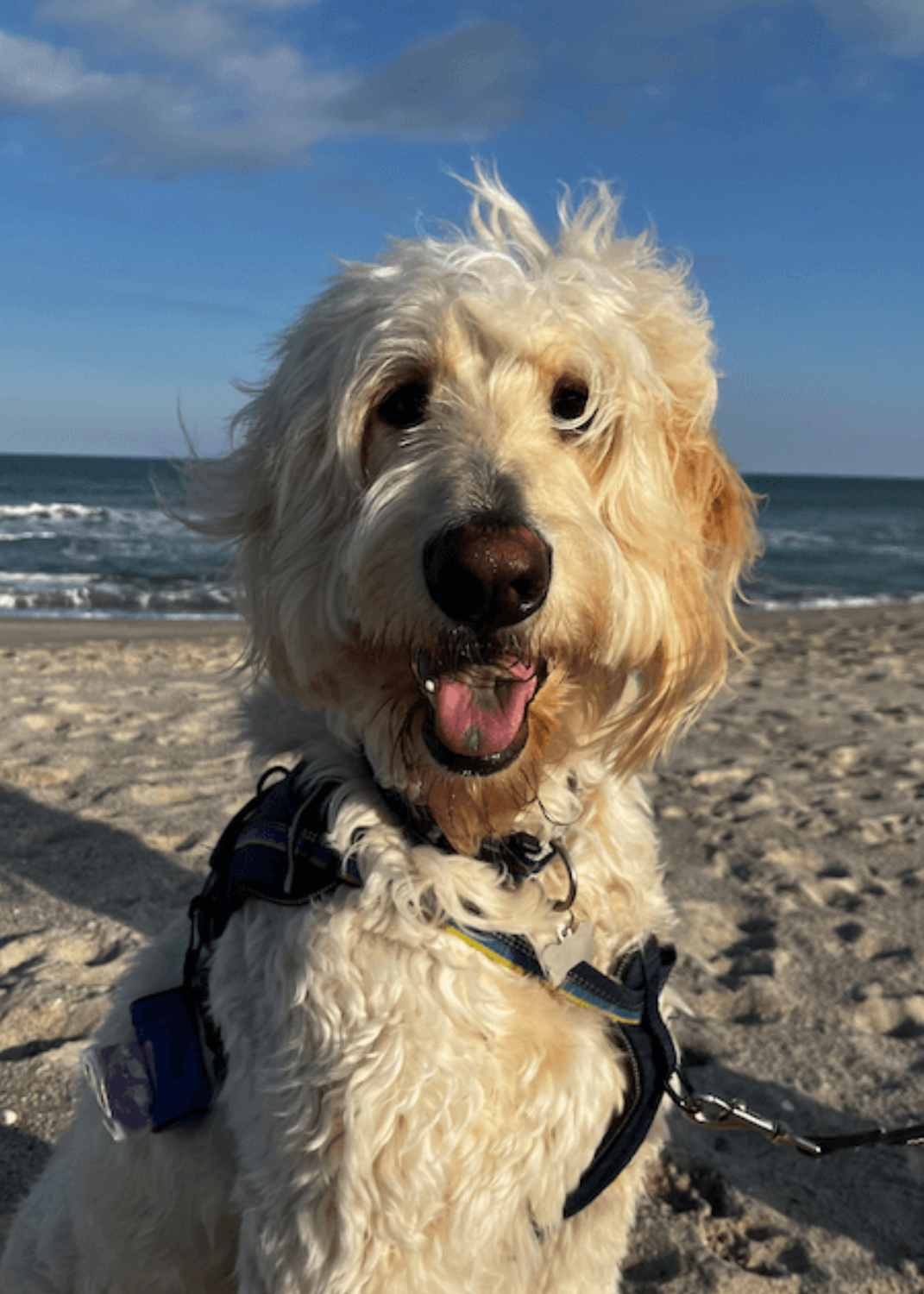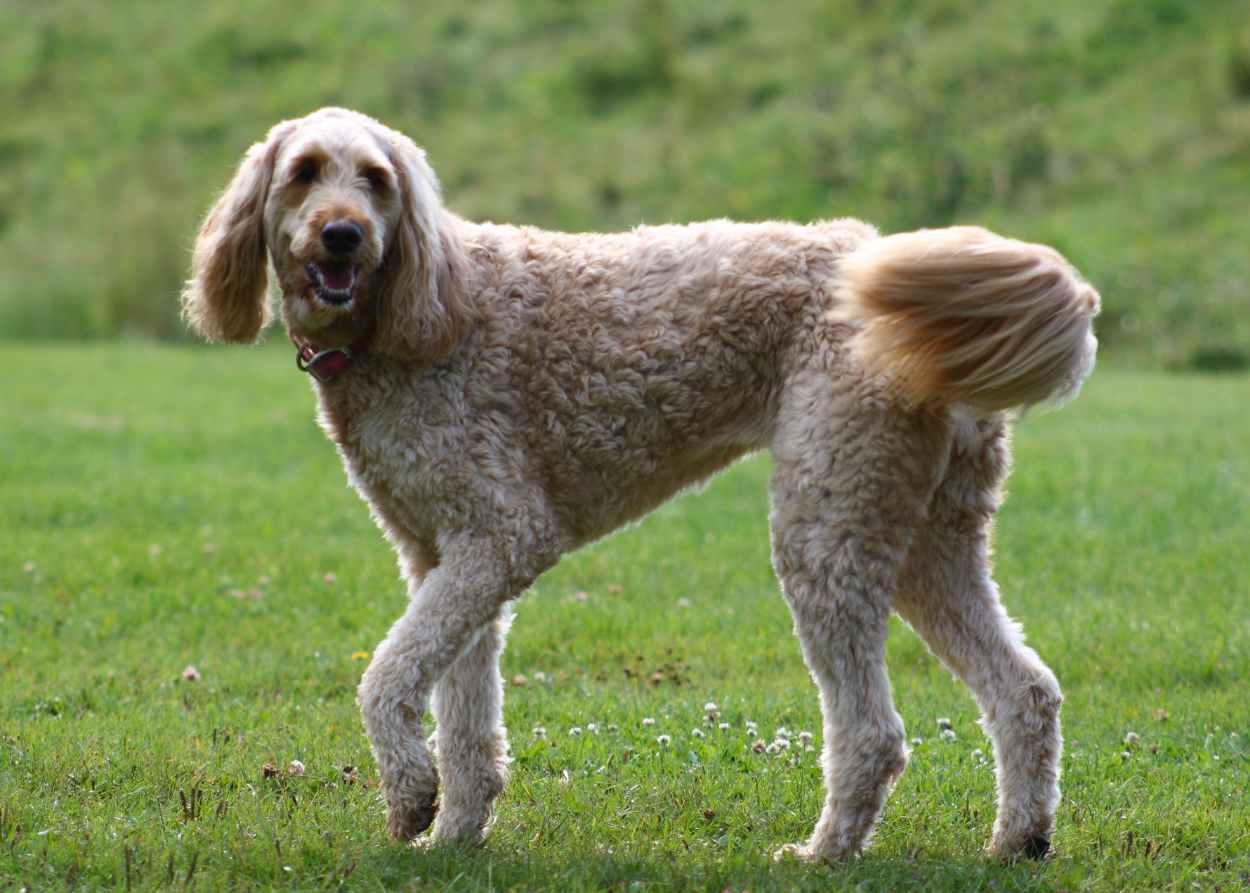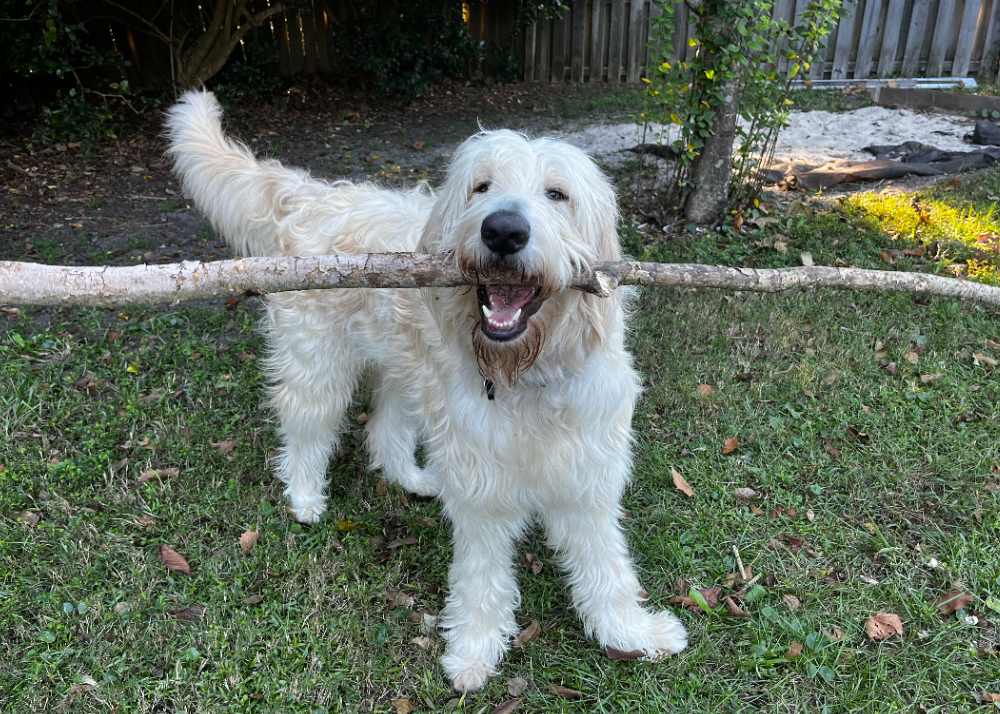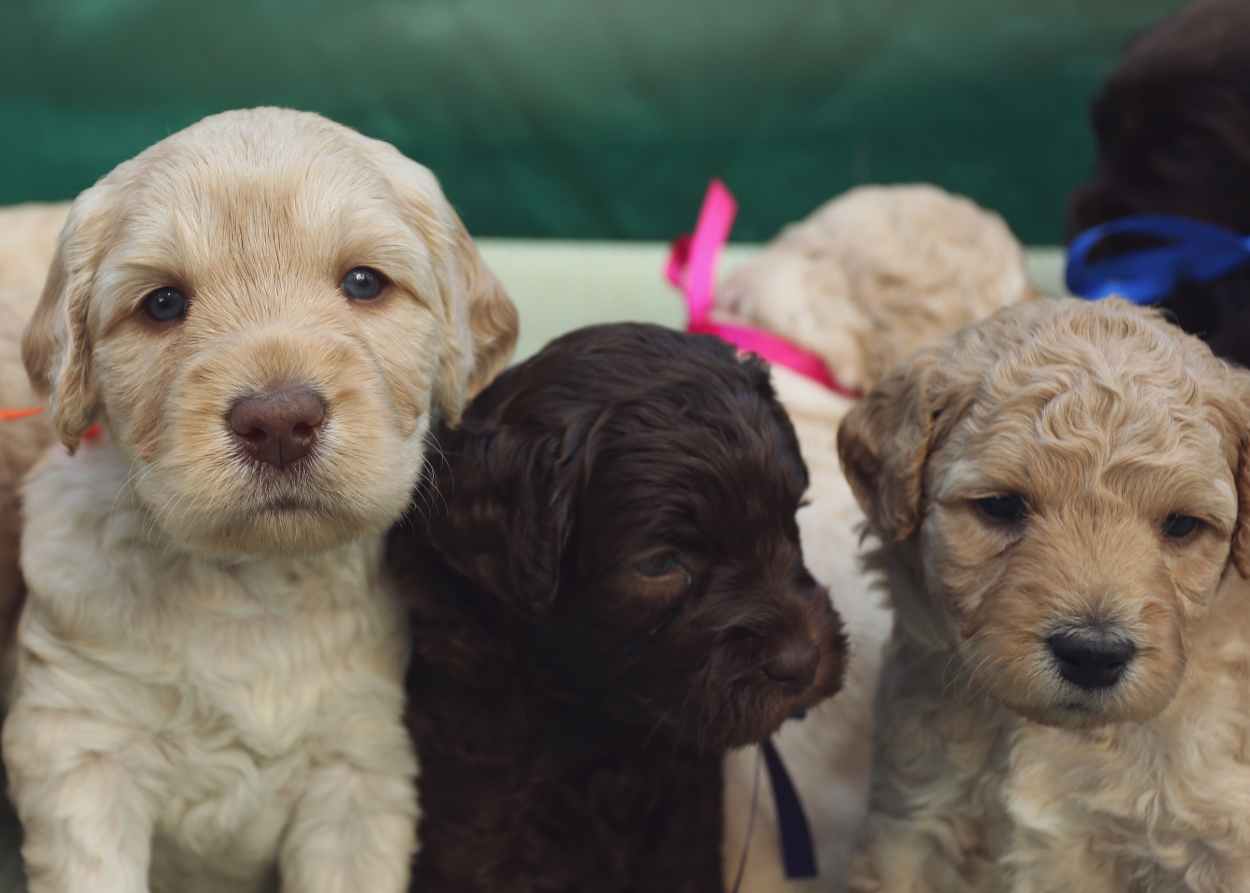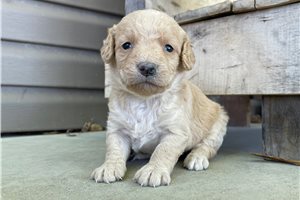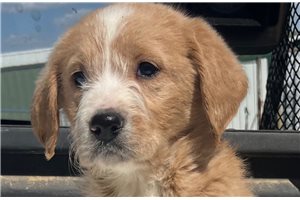What do you get when you cross a Labrador Retriever with a Poodle?
A Yankee-doodle-dandy? A Poodle doodle noodle? Labracadabra?
No, a Labradoodle!
A Labradoodle puppy is the result of breeding a Labrador Retriever with a Poodle of any size, usually a Standard Poodle. A Labradoodle can also be a Labradoodle bred with a purebred parent breed (usually a Poodle) or two Labradoodles. They are called hybrid, designer, or crossbred dogs due to their purebred parent lineage. This mix results in a spirited, peppy dog that can serve as a fantastic pet for a variety of people who can meet its needs. Labradoodle puppies have such an array of temperaments, sizes, and coat types making them one of the most diverse and adaptable hybrid crossbreeds today.
Labradoodles in the United States are wildly popular choices for family pets, and it’s easy to see why when you examine their amazing qualities. They’re sociable and friendly, patient with children, love to play, loyal to their families, very intelligent, have hypoallergenic traits, and easy to train. What’s not to love?
Learn all about Labradoodle puppies to see if this designer hybrid doodle dog is the right choice for you and your family.
Goose the Labradoodle loves to run and play at the beach
The History and Origin of Labradoodle Puppies
Mixes of Poodles and Labrador Retrievers may have been conceived naturally as a random mixed breed, but it wasn’t until a few decades ago that they were bred for a specific purpose. Breeders for the Royal Guide Dogs Association of Australia in the late 1980s-early 1990s began breeding Labradoodles as one of the first hybrid dogs bred specifically to be hypoallergenic therapy dogs for the blind. Breeders sought to combine the intelligence and hypoallergenic coat of a Poodle and the friendly personality of a Labrador Retriever to result in a highly trainable service dog suitable for clinical environments.
Today, Labradoodles are as common as other dogs like Golden Retrievers and other popular breeds. Labradoodles were ranked #7 among the most popular dog breeds in 2020. In addition to finding them in your neighborhood and at local dog parks, several celebrities have cherished their Labradoodles: Tiger Woods (Yogi and Riley the Labradoodles), Graham Norton (Bailey), and Christie Brinkley (Maple Sugar) have all owned or currently own Labradoodles.
Are Labradoodles purebred or hybrid?
While Labradoodles in the United States are not recognized as purebred dogs, certain Labradoodles in Australia called Australian Labradoodles or Australian Cobberdogs have full recognition as purebred dogs. “Cobberdog” means "dog-friend," and these dogs are bred specifically as therapy dogs that perform assistance tasks with their own recognized stable DNA sequence. The Master Dog Breeders Association (MDBA) issues Australian Cobberdog pedigrees for dogs only from registered breeders. The MDBA “ensures the health, predictability of temperament, characteristics and management requirements” of what a purebred Australian Cobberdog should be.
While it’s rare to see an Australian Cobberdog in America, Labradoodles still have plenty of opportunities to join some registries in America. Some kennel clubs that welcome Labradoodles to their rosters are:
Do All Labradoodles Look and Act the Same?
As hybrid breeds, genetics rules how a dog looks and acts due to various traits inherited and exhibited in the Labradoodle puppy. They can inherit any trait from their parents, and there’s no way to predict which ones will be dominant. From personality to looks, every Labradoodle is unique, even those from the same litter.
This Labradoodle favors its Poodle parent.
How can you tell a Labradoodle’s genetic composition?
If you’re looking to adopt a Labradoodle, you may notice a series of letters and numbers to describe which generation it is. Here’s a simplified explanation:
- F1: Labrador Retriever x Poodle
- F1B: Labradoodle x Poodle makes the puppy 25% Labrador Retriever and 75% Poodle.
- F2: Two F1 Labradoodles bred together
- Multigenerational: A combination of established Labradoodles bred together
With F1 Labradoodles, a puppy can exhibit different personality traits dominant in one breed over the other, or they could be a balance of the two. Poodles come in over 20 different colors and patterns. Combined with a Labrador Retriever’s color choices, you never know what colors or patterns will show even among the same litter.
This Labradoodle has a long, wavy coat and a Labrador Retriever's ears.
A Labradoodle can take on a more Poodle-like look with long, pendulous ears, a tight, curly coat, a bigger frame, or a longer muzzle. They could also have longer, wavy hair with faces and ears more Lab-like and be a bit smaller in size. Their differing coat textures also mean your Labradoodle can still shed and not be as allergy-friendly as desired. In general, the more Labradoodles are bred to each other generationally, the less dander and shedding will occur. You can look at both parents’ sizes to predict your Labradoodle’s size which can be categorized as mini, medium, or standard size. Mini Labradoodles weigh 15-25 lbs. and stand 14-16 in. on average, and a Standard Labradoodle can be a wide range of height and weight, from 40-90 pounds and 17-24 in. tall. While you can use Labradoodle growth and weight charts for guidance, be prepared for your Labradoodle to grow to any size!
Regardless of your Labradoodle’s generation, we can all agree they are simply adorable with their cute button noses, inquisitive, bright eyes, and joyous spirits.
Exercise and Training Needs of Labradoodles
Be prepared to never have a dull moment again when you are a Labradoodle owner! Labrador Retrievers and Poodles are athletic, energetic, eager-to-please dogs, so a Labradoodle will inherit some or all of these traits. A Labradoodle has the same enthusiasm for life as a small child – you can imagine how active they can be. They are exuberant and boisterous, so Labradoodle puppy owners need to be prepared to properly channel their energy. Labradoodles can experience an extended puppy-like attitude till around age 3, so you’ll encounter lots of fun and shenanigans along the way.
Labradoodle puppies need up to an hour of vigorous exercise and mentally stimulating activity per day. A Labradoodle puppy is always up for an adventure, whether you are exploring a new hiking trail, going on a run, or visiting a dog park. They make great running partners and love to play.
Congratulate Goose on his promotion to Branch Manager
Training a Labradoodle puppy
Training your Labradoodle puppy can be a rewarding experience, but you have to have patience and consistency. They respond best to praise and positive reinforcement, and you should never use harsh punishments.
Socializing your Labradoodle puppy is imperative since they can be so enthusiastic and outgoing at large sizes. Begin exposing them to sights, sounds, experiences, people, and other pets as soon as you can. An untrained Labradoodle can cause accidents and harm someone (think jumping up on a child), so good manners are a must.
Labradoodles make excellent therapy dogs and can receive special training past basic training and at an appropriate age. They have several qualities that are naturally suited toward being in therapy settings assisting humans with various tasks: Friendly, hardworking, intelligent, obedient, gentle, and hypoallergenic.
The Importance of Grooming Your Labradoodle Puppy
Labradoodle puppy owners should understand what it requires to groom a doodle mix. You must be committed to keeping them healthy through grooming.
Think of you and your groomer as a team in maintaining their coats. If you only rely on a professional groomer to do all the work and neglect what you need to do at home, you will encounter health issues that may affect your Labradoodle’s overall well-being and not just the coat! Mats can easily form in just two days and form first on their chests, behind or under the ears, neck, and armpits. Some health issues stemming from coat neglect include painful mats that tug at the skin, skin infections, and even spine and joint problems from added weight from mats.
Not only do you need to devote the time and effort to take them to the groomer and care for them at home, but you also need to make sure it fits into your budget. As a financially responsible dog owner, be sure to include this cost as a regular expense of owning a Labradoodle puppy.
Professional grooming
Labradoodles require regularly scheduled grooming appointments every 4-6 weeks, so make sure you choose a groomer nearby in your budget since you’ll be going there frequently. Sometimes they will perform a brush, bath, dental check, and nail trim, and other visits will include a full cut or ear plucking to remove accumulated dead hairs from blocking the ear canal that could cause infections. Baths are usually done at the grooming facility due to the drying needed to prevent mats from forming.
Another major factor to understand is Labradoodles may take up more than one appointment slot and require more skills to groom than other breeds. For these reasons, the cost of grooming a Labradoodle may be significantly higher and take longer.
Begin bringing them to the groomer as soon as your Labradoodle has all of its shots since it will be there quite a bit and needs to get used to the process as soon as possible.
Types of cuts and styles
Labradoodle puppy owners have a wide variety of haircuts and styles they can choose for their Labradoodle. A professional groomer can recommend styles that work well for the particular coat texture and type along with how much daily time and maintenance you want to spend on the coat. Some popular style choices are:
- Puppy Cut or Short Clip: This no-fuss style offers a short, evenly trimmed coat 1-2 inches all over their bodies maintaining a fluffy texture and manageable length.
- Schnauzer Cut: Inspired by Mini Schnauzer styles, this cut keeps the body short while leaving longer hair on the legs, eyebrows, and beard.
- Long Clip/Teddy Bear Clip: Keeping a Labradoodle’s hair 2-3 inches keeps their curls but requires more attention to brushing daily. Labradoodles can look like fluffy teddy bears with this cut, especially with a rounded head and after a good brushing.
At-home grooming
You will need to be hands-on in your grooming efforts between regularly scheduled professional groomer appointments. It’s a great opportunity to learn some skills for grooming your puppy at home.
Beginning regular brushing early in your dog's life is crucial for their grooming routine. You should start a brushing routine as soon as your furry friend becomes a part of your family and introduce it as part of their daily lives. Aim to brush your dog from head to toe at least four times weekly until their adult coat has fully developed. By around 18 months of age, your puppy will have transitioned to their adult coat. However, the discarded puppy hair does not fall out from the coat naturally like other dogs that shed, so you have to remove it by brushing.
To kickstart your grooming regimen, ensure you have the necessary grooming tools for DIY dog grooming at hand, including a quality pin or slicker brush, a de-matting metal comb, leave-in conditioner spray, a doggy toothbrush and toothpaste, nail trimmers, and eye and ear cleaning solution. Additionally, consider investing in scissors with rounded tips for delicate areas around the eyes. These tools are essential for maintaining your dog's coat health and appearance. Grooming your dog at home is an excellent way to check for any skin irritations, mats, cuts, and ear, eye, or paw issues.
Proper coat-brushing techniques for Labradoodles
Using a slicker brush, part hair into sections starting at the top of the spine and work your way down. Be sure to get close to the skin where you can easily miss mats if you only do the surface. After you’ve used a slicker brush all over, go back through with a metal comb.
Health Concerns of Labradoodles
Labradoodles can live 12-15 years with proper veterinary care and if provided a high-quality life. However, like any breed, they could face some health challenges. Labradoodles can be genetically predisposed to certain health conditions, such as hip and elbow dysplasia, heart disease, skin allergies, otitis and other ear issues, gastrointestinal disorders, and some cancers.
However, data supports that Labradoodles are healthier than their parent breeds when it comes to cancer claims. A Nationwide Pet Insurance study examined 1.61 million claims 2015-2021 and found that compared to all other dogs, Labradoodles are a little more than half as likely at 61.9% to have a claim for cancer than other dog breeds, and the parent breeds of Labradoodles are 2.5 times more likely to have a claim submitted for cancer than Labradoodles.
How Do I Find a Trustworthy Labradoodle Breeder?
You may find several options when it comes to finding a Labradoodle puppy for sale because they are such popular dogs. But how do you know which one to pick?
You’ll quickly find that not all sellers have you or your puppy’s best interests in mind. Puppy scammers do everything they can to make money without regarding the well-being of puppies. They may steal other people’s photos and advertise those puppies as their own. Puppy scammers may also sell you the wrong breed completely with no parent information, birthday, or proof of veterinary care, capitalizing on the fact that most doodle breeds look similar as puppies. They will take payment via unsecured methods, leaving you completely unprotected.
You may find a backyard breeder offering actual Labradoodles, but this option is not much better. Without oversight, you can’t be sure they are upholding the highest breeding standards and environment for those puppies. They may not keep records of parents’ traits and health history and carelessly breed them together, resulting in personality or health problems.
Pet stores are rampant with puppies from abhorrent puppy mills where puppies and dams are raised in horrible, unsanitary conditions without the proper veterinary care, nutrition, and love. Never buy a puppy from a pet store!
So where can you turn when searching for a Labradoodle puppy?
Pawrade Offers Happy Labradoodle Puppies
At Pawrade, we utilize a network of breeder partners that have been hand-selected to offer Labradoodle puppies for adoption. All puppies come with a comprehensive health guarantee, current veterinary records, a health certificate, and 30 days of MetLife insurance. We also offer a secure transaction management system experience via PetPay and will never ask for payment using unsecure apps, moneygrams, or gift cards. Our team support for your puppy adoption journey is unrivaled in the pet adoption space.
Our Puppy Concierge team cannot wait to hear from you to help you select the perfect Labradoodle for you. Browse our Labradoodle puppies for sale to find your own live teddy bear to cuddle with forever!

